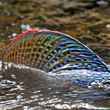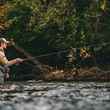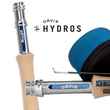Despite the fact that the internet is lousy with grip-and-grin shots with snowy shores lurking behind the angler, I'm often shocked to hear how many fly fishermen consider wintertime 'tying season'. In other words, the waders, boots, rods and reels get stowed for the season, and the vice gets a workout. It is as if these anglers imagine that trout spend their winters in hibernation, rousing in the spring when the hatches start to go off. Of course this is not the case, trout feed throughout the winter, albeit at a slower pace than they do in warmer seasons.
So, rest assured, there are trout to be caught all year long. Whether the temperature is 40 degrees or 14 degrees, trout will be feeding. Air temperature will almost certainly play a larger role in whether you decide to leave warm, dry confines of your home than whether or not the trout are feeding. However, despite the fact that fish will feed and take flies throughout the winter, there are definitely changes in a fish's behavior as winter and its cooler temperatures takes hold, and the angler should adjust his or her approach accordingly.






























